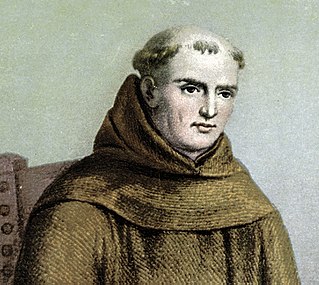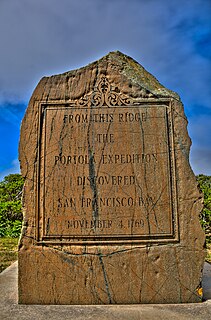This article needs additional citations for verification .(April 2014) |
Francisco Dumetz (died 14 January 1811) was a Spanish Franciscan missionary. He gave the San Bernardino Valley in California its name, in 1810. [1]
This article needs additional citations for verification .(April 2014) |
Francisco Dumetz (died 14 January 1811) was a Spanish Franciscan missionary. He gave the San Bernardino Valley in California its name, in 1810. [1]
He was a native of Majorca, Spain, where he entered the Franciscan Order. In May, 1770, he went to Mexico with forty-eight other Franciscans to join the Franciscan missionary college of San Fernando in Mexico City.
On volunteering for the Indian missions, he was sent to California in October, 1770. Sailing from San Blas, Jalisco, with ten friars in January, 1771, he reached Monterey in May and was assigned to Mission San Diego. In May, 1772, he was transferred to Mission San Carlos Borromeo de Carmelo, and in May, 1782, was appointed for Mission San Buenaventura.
There he continued his mission work until August, 1797, when he was directed to found Mission San Fernando. Father Dumetz remained there from its founding on 8 September to the end of 1805, except during 1803 and 1804 when apparently he resided at San Gabriel.
From January, 1806, to the time of his death, Father Dumetz was stationed at San Gabriel. His remains were buried in the mission church on 15 January. Dumetz was the last of the pioneer friars in California, where he worked without interruption for forty years.

The Spanish missions in California comprise a series of 21 religious outposts or missions established between 1769 and 1833 in what is now the U.S. state of California. Founded by Catholic priests of the Franciscan order to evangelize the Native Americans, the missions led to the creation of the New Spain province of Alta California and were part of the expansion of the Spanish Empire into the most northern and western parts of Spanish North America.

Mission San Gabriel Arcángel is a Californian mission and historic landmark in San Gabriel, California. It was founded by Spaniards of the Franciscan order on "The Feast of the Birth of Mary," September 8, 1771, as the fourth of what would become twenty-one Spanish missions in California. San Gabriel Arcángel was named after the Archangel Gabriel and often referred to as the "Godmother of the Pueblo of Los Angeles." The mission was built and run using what has been described as slave labor from nearby Tongva villages, such as Yaanga. When the nearby Pueblo de los Ángeles was built in 1781, the mission competed with the emerging pueblo for control of Indigenous labor.

Mission San Buenaventura, formally known as the Mission Basilica of San Buenaventura, is a Catholic parish and basilica in the Archdiocese of Los Angeles. The parish church in the city of Ventura, California, United States, is a Spanish mission founded by the Order of Friars Minor. Founded on March 31, 1782, it was the ninth Spanish mission established in Alta California and the last to be established by the head of the Franciscan missions in California, Junípero Serra. Designated a California Historical Landmark, the mission is one of many locally designated landmarks in downtown Ventura.

Mission San Fernando Rey de España is a Spanish mission in the Mission Hills community of Los Angeles, California. The mission was founded on 8 September 1797, and was the seventeenth of the twenty-one Spanish missions established in Alta California. Named for Saint Ferdinand, the mission is the namesake of the nearby city of San Fernando and the San Fernando Valley.

Junípero Serra y Ferrer was a Spanish Roman Catholic priest and missionary of the Franciscan Order. He is credited with establishing the Franciscan Missions in the Sierra Gorda, a UNESCO World Heritage Site. He later founded a mission in Baja California and the first nine of 21 Spanish missions in California from San Diego to San Francisco, in what was then Spanish-occupied Alta California in the Province of Las Californias, New Spain.

Francisco Hermenegildo Tomás GarcésO.F.M. was a Spanish Franciscan friar who served as a missionary and explorer in the colonial Viceroyalty of New Spain. He explored much of the southwestern region of North America, including present day Sonora and Baja California in Mexico, and the U.S. states of Arizona and California. He was killed along with his companion friars during an uprising by the Native American population, and they have been declared martyrs for the faith by the Catholic Church. The cause for his canonization was opened by the Church.
Pedro Fages was a Spanish soldier, explorer, first Lieutenant Governor of the Californias under Gaspar de Portolá. Fages claimed the governorship after Portolá's death, acting as governor in opposition to the official governor Felipe de Barri, and later served officially as fifth (1782–91) Governor of the Californias.
José María de Zalvidea was a Spanish Franciscan missionary. He was born at Bilbao, Vizcaya, Spain, and became a Franciscan at the convent of San Mames, Cantabria, on 13 December 1798. He joined the College of San Fernando de Mexico in 1804 and became a missionary to the California Native Americans in August 1805.
Buenaventura Sitjar was a Franciscan missionary who served in California until his death.

The Portolá expedition was a Spanish voyage of exploration in 1769–1770 that was the first recorded European land entry and exploration of the interior of the present-day U.S. state of California. It was led by Gaspar de Portolá, governor of Las Californias, the Spanish colonial province that included California, Baja California, and other parts of present-day Mexico and the United States. The expedition led to the founding of Alta California and contributed to the solidification of Spanish territorial claims in the disputed and unexplored regions along the Pacific coast of North America.
Francesc Palou or Francisco Palóu (1723–1789) was a Spanish Franciscan missionary, administrator and historian on the Baja California Peninsula and in Alta California. Palóu made significant contributions to the Alta California and Baja California mission systems. Along with his mentor, Junípero Serra, Palóu worked to build numerous missions throughout Alta and Baja California, many structures of which still stand today. A member of the Franciscan Order, Palóu became "Presidente" of the missions in Baja California, and later of missions of Alta California. Palóu's work in the Spanish mission system spans from his early twenties to his death at the age of 66.
Father José Francisco de Paula Señan was a Spanish missionary to the Americas.
Father Marià Paieres i Borràs (Catalan), commonly known as Mariano Payeras Borrás or Padre Mariano Payeras was a Spanish missionary to the Americas.

Luis Jayme O.F.M., born Melcior Jaume Vallespir, was a Spanish-born Roman Catholic priest of the Franciscan Order. Born at the farm Son Baró in the village of Sant Joan, Majorca, his earliest schooling was acquired from the local parish priest. At the age of fifteen Melchor was enrolled at the convent school of San Bernardino, where Fray Junípero Serra had studied some years earlier.
Father Gregório Amúrrio, O.F.M. was a Catholic priest of the Franciscan Order, and a Spanish missionary in California during the 18th century. A member of the Franciscan Province of Cantabria, Spain, he was one of twenty Franciscans who set out from the missionary College of San Fernando de Mexico in October, 1770 to labor in the Spanish missions in Baja California.
The College of San Fernando de México was a Roman Catholic Franciscan missionary college, or seminary, founded in Spanish colonial Mexico City by the Franciscan Order of Friars Minor on October 15, 1734.
Father Vicente Fustér, O.F.M. was Catholic a priest of the Franciscan Order, and a Spanish missionary in California during the 18th century. A member of the Franciscan Province of Cantabria, Spain, he was one of twenty Franciscans who set out from the missionary College of San Fernando de Mexico in October, 1770 to labor in the Spanish missions in Baja California. On November 24, 1771 he arrived at Loreto with fourteen of his colleagues. In the summer of 1773 the Franciscans surrendered all missions on the Baja Peninsula to the Dominicans, after which Father Amúrrio along with five other friars volunteered to work the new missions in Upper California. Upon arrival in San Diego on August 30, Fray Fustér was assigned to Mission San Diego de Alcalá to take the place of Father Tomás de la Peña.
Father Vicente de Santa María was a Spanish Franciscan priest who accompanied explorer Juan de Ayala on the first Spanish naval entry aboard the San Carlos into the San Francisco Bay. Born in the village of Aras in Navarre Province, Spain, Santa Maria moved to Mexico City to attend the Colegio de San Fernando seminary in 1769. Santa Maria wrote detailed first-hand accounts of the journey of the San Carlos and of the indigenous inhabitants of the San Francisco Bay Area prior to Spanish colonization. He later served at Mission San Francisco de Asis in San Francisco and Mission San Buenaventura in Ventura, California, where he died in 1806.

Francisco García Diego y Moreno, OFM, was the first bishop of the Diocese of the Californias.

The Mexican Secularization Act of 1833, officially called the Decree for the Secularization of the Missions of California, was an act passed by the Congress of the Union of the First Mexican Republic which secularized the Californian missions. The act nationalized the missions, transferring their ownership from the Franciscan Order of the Catholic Church to the Mexican authorities.
![]() This article incorporates text from a publication now in the public domain : Herbermann, Charles, ed. (1913). Catholic Encyclopedia . New York: Robert Appleton Company.
This article incorporates text from a publication now in the public domain : Herbermann, Charles, ed. (1913). Catholic Encyclopedia . New York: Robert Appleton Company.{{cite encyclopedia}}: Missing or empty |title= (help)